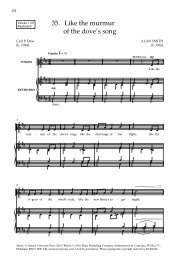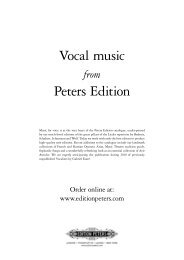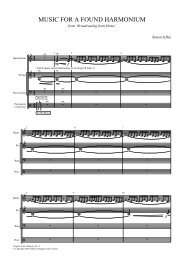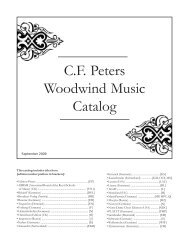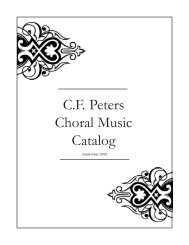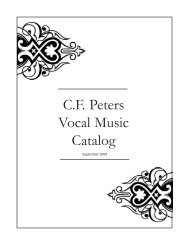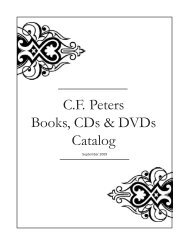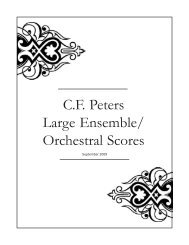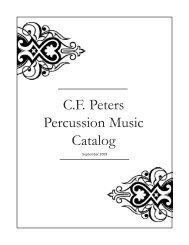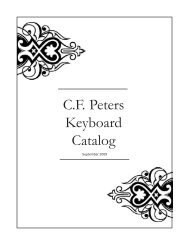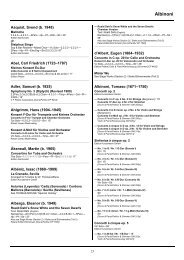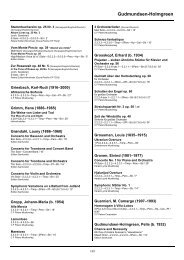C.F. Peters String Music Catalog - Peters Edition Ltd
C.F. Peters String Music Catalog - Peters Edition Ltd
C.F. Peters String Music Catalog - Peters Edition Ltd
You also want an ePaper? Increase the reach of your titles
YUMPU automatically turns print PDFs into web optimized ePapers that Google loves.
From the Vault<br />
If you’re looking for something a little off the beaten track of standard repertory, or something that may<br />
have been popular in the past but has been forgotten, or maybe something that never got the attention<br />
it deserved -- look no further. Presented here are some worthy works or collections that we’re dusting off<br />
and presenting for your consideration and enjoyment.<br />
Lumsden, Caroline<br />
• Witches’ Brew (with CD)<br />
• Wizard’s Potion (with CD)<br />
These pieces are for beginner violinists (EP 7676 & 7678) and cellists<br />
(EP 7677 & 7679): Witches’ Brew is for open strings and 1 st<br />
position, and Wizard’s Potion is for 1 st and 2 nd position. Children will<br />
be charmed by the illustrations, jazzy accompaniments, fun lyrics (for<br />
whispering or singing), finger snapping, clapping, tapping on the<br />
violin--and in “Stinkbomb Surprise” it even asks for cauldron stirring<br />
motions with the bowing arm.<br />
The CDs include performances with piano so you can hear what it<br />
should sound like, and performances of just the piano so you can<br />
play along. The piano parts, which include teaching points, require<br />
someone with intermediate piano skills. Half of the violin works are<br />
in the same key as the cello versions so mixed string groups can play<br />
together.<br />
Stevens, Halsey<br />
• Five Duos for 2 Cellos (EP 6028)<br />
Halsey Stevens’ work has been described as “functional,”<br />
underlying his belief that “theory that comes before practice stands<br />
on shaky ground.”<br />
These cello duos have been characterized as easy, and though the<br />
notes themselves are not hard this music poses some challenges: it<br />
only hovers around traditional tonality, and has some tricky rhythms,<br />
chromaticism and dissonances. A good introduction to 20 th Century<br />
music for student cellists ready to expand their horizons.<br />
Chaplin, Charlie<br />
• Oh! That Cello!<br />
(GM 1250 A, -B, -C, -D, -E and -F)<br />
Charlie Chaplin is still remembered widely for his films, but he was<br />
also a versatile entertainer and businessman. Chaplin not only wrote<br />
music to accompany his silent films but started a publishing company<br />
to sell his music; the business failed after a few years, but his cello<br />
arrangements titled “Oh! That Cello!” have been resurrected by<br />
<strong>Edition</strong> Kunzelmann with editor Thomas Beckmann.<br />
Chaplin’s music is very tuneful, and you won’t find anything<br />
particularly surprising in terms of harmony or rhythm in the 6<br />
volumes. The piano often doubles the cello, and both players need<br />
at least intermediate skills to tackle this music. Each volume has<br />
3-5 songs in it, with titles like “Park Avenue Waltz,” “Tango<br />
Natascha” and “A Countess From Hongkong.”<br />
Beach, Mrs. H.H.A.<br />
• Sonata for Viola and Piano, Op. 34 (EP 66847)<br />
Born in 1867, Amy Marcy Cheney Beach was the most successful<br />
American woman composer of her time. After marriage, she<br />
changed her focus (at her husband’s request) from her career in<br />
performance to composition, and later also served as leader of the<br />
MTNA and MENC.<br />
This sonata, originally for violin, is full of the lush harmonies and<br />
chromaticisms of the late Romantic era, and demonstrates the<br />
expressiveness her vocal music is known for. Not surprisingly,<br />
since she debuted this work along with Franz Kneisel (who was<br />
concertmaster of the Boston SO at age 20), the piano part is as<br />
challenging as the viola part.<br />
Josquin Des Pres<br />
• La Spagna (arr. string quintet) (EP 67437)<br />
This fantasia by Josquin is based on the basse-danse melody “Il re<br />
di Spagna,” and though it was meant for a five-part wind-band it<br />
is edited agreeably here for strings, and may be played by string<br />
quintet (2 violins, viola and 2 cellos), viol consort or string<br />
orchestra. In its history is a less than agreeable version as a motet,<br />
with words that didn’t quite fit, and little place for the singers to<br />
breathe, especially the tenor (melody).<br />
The ranges are small but the rhythms have all the characteristics<br />
of early music, so an ensemble of intermediate players should<br />
tackle this without much difficulty.



